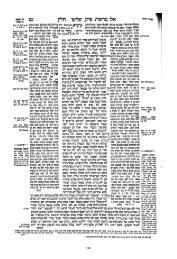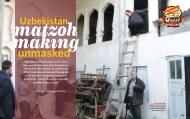jews-of-eritrea - Halachic Adventures
jews-of-eritrea - Halachic Adventures
jews-of-eritrea - Halachic Adventures
You also want an ePaper? Increase the reach of your titles
YUMPU automatically turns print PDFs into web optimized ePapers that Google loves.
ANY<br />
JEWS LEFT IN<br />
Although the Eritrean capital <strong>of</strong> Asmara is less than 1,000<br />
miles from Tel Aviv, this quaint African-Italian city is the last<br />
place you might expect to find a Jewish community. However,<br />
we discovered a fully equipped, well-cared-for synagogue, a<br />
kosher mikveh, and a Jewish cemetery — all testimonies to<br />
once-vibrant Jewish life. Who actually lived in Eritrea How<br />
did they get there And what light can its Jewish connections<br />
shed on the Jews <strong>of</strong> neighboring Ethiopia Mishpacha travels<br />
to this African backwater, which in its own way <strong>of</strong>fered<br />
shelter, safety, and financial opportunities during a precarious<br />
century, when none <strong>of</strong> that could be taken for granted<br />
Ari Z. Zivot<strong>of</strong>sky and Ari Greenspan<br />
Many people won’t be able to tell you where Eritrea is,<br />
or even whether it is a city, a country, or a neurological<br />
condition. Map-lovers, however, know that Eritrea is a<br />
small East African country flanked by Sudan in the west, Ethiopia<br />
in the south, and Djibouti in the southeast, and directly across the<br />
Red Sea from Saudi Arabia and Yemen. As part <strong>of</strong> our quest to<br />
explore remnants <strong>of</strong> Jewish communities around the globe, we<br />
were curious: what Jewish community could have existed in such<br />
a remote and isolated location, and what history could we expect<br />
to find<br />
We recently took a trip to the Eritrean capital <strong>of</strong> Asmara, a city<br />
situated on a plateau on the northwestern edge <strong>of</strong> the Great Rift<br />
Valley, to explore the remnants <strong>of</strong> the Eritrean Jewish community.<br />
To the best <strong>of</strong> our knowledge, during the time we were there,<br />
only two other Jews were in the country — the new Israeli consul<br />
and his young wife. Looks can be deceiving, though, and while<br />
the small Jewish community <strong>of</strong> Asmara was not ancient, it was<br />
exceedingly vibrant.<br />
In Asmara, there remains one pious Jew, Mr. Sami Cohen.<br />
Now in his early sixties, Cohen fondly remembers the heyday<br />
<strong>of</strong> Asmara Jewry and ensures the upkeep <strong>of</strong> the synagogue so<br />
that any traveler can walk in any day <strong>of</strong> the year and daven. And<br />
indeed, we did just that one day this past summer.<br />
We arrived in Asmara late one night after an entire day flying.<br />
Although Asmara is less than 1,000 miles from Tel Aviv, there are<br />
very few flights to this poor, backward country. One can reach<br />
Asmara only by flying through Cairo, Sana’a, or Jeddah; thus we<br />
were required to fly via Frankfurt and Jeddah, in a seventeen-hour<br />
trip. Locals later told us that Air Eritrea, currently nonoperational,<br />
will be back up and running once its two planes are repaired.<br />
After arriving in what can only be described as the lowest-tech<br />
international airport in the world and sleeping in this quaint<br />
African-Italian city, we found ourselves the following morning in<br />
a fully equipped shul, lacking only a minyan. It was clean, well-lit,<br />
stocked with siddurim and other required books, plus two sifrei<br />
Torah, all being taken care <strong>of</strong> by Sami.<br />
We had met with Sami in Israel prior to our sojourn, and<br />
while Sami was actually not in Eritrea when we visited, we felt<br />
his presence, whether it was by gaining access to the shul, by<br />
obtaining kosher food, or by arranging housing details. He cares<br />
for the shul as if it were his own home. The non-Jewish woman he<br />
employs to clean and care for the building has been dedicated to<br />
her job for over forty-five years.<br />
“I remember what this community was like when I was child,”<br />
says Sami. “We had schools and social programs and lectures. It<br />
was vibrant and beautiful.” Everyone we spoke with — from the<br />
lady in the printing shop to a young man in the Internet cafe —<br />
seems to know and respect Sami. He is Eritrea’s Jewish icon.<br />
What kind <strong>of</strong> Jewish community existed in this obscure<br />
54 20 Elul 5769 9.9.09 55
Following the European colonization <strong>of</strong> most <strong>of</strong> Africa in the nineteenth century, Adenite Jews<br />
sensed opportunities and began doing business along the eastern African coast, moving their<br />
families along with them. This was the beginning <strong>of</strong> the Asmara kehillah<br />
African country Among the earliest Jewish inhabitants <strong>of</strong> Asmara<br />
— a city 7,000 feet above sea level with an inviting climate<br />
— were the Behar brothers, Uriel and Nissim, who came from<br />
Istanbul in 1890. They started a business that grew to become one<br />
<strong>of</strong> Eritrea’s largest export firms. As the Jewish community grew,<br />
they realized there was a need for a shul, and in 1906 Uriel, who<br />
was the first president <strong>of</strong> the community, received a plot <strong>of</strong> land for<br />
a synagogue from the ruling Italian colonial authorities. Because<br />
the land was to be used for religious purposes, it was given free<br />
<strong>of</strong> charge. Construction began immediately. About a third <strong>of</strong> the<br />
allocated land was used for the shul, with the rest being used for<br />
the school, <strong>of</strong>fices, mikveh, and yard. As Sami says: “There was<br />
a Jewish school in the compound <strong>of</strong> the synagogue. We were<br />
fortunate to have a teacher who gave us lessons in the afternoons<br />
Jewish fighters exiled by<br />
the British to Eritrea’s penal<br />
colony, Devil’s Island-style<br />
The fully-equipped shul<br />
only lacks a minyan<br />
and on holidays, and taught students <strong>of</strong> all ages.” Recently a onehundredth<br />
anniversary event was held for the shul, for which many<br />
former members returned.<br />
From Across the Sea Most <strong>of</strong> the Jews in Asmara were<br />
not from Istanbul, but rather from the southern Yemeni port city<br />
<strong>of</strong> Aden, about which we’ll learn more below. Eritrea was not<br />
alone in having a Diaspora Adenite community. The entire eastern<br />
coast <strong>of</strong> Africa had a little-known chain <strong>of</strong> Jewish communities<br />
that began in the late nineteenth century and peaked in the midtwentieth<br />
century. Starting from the north and proceeding toward<br />
the south, there were Adenite communities in Asmara and<br />
Massawa, Eritrea; Addis Ababa and Dire Dawa, Ethiopia; Djibouti;<br />
Mogadishu, Somalia; and Nairobi, Kenya. These communities<br />
were predominantly made up <strong>of</strong> Yemenite Jews who came to<br />
Africa, starting in the late 1800s, to seek their fortunes, and who<br />
were later joined by Sephardic Jews and still later by Ashkenazim<br />
escaping from Europe.<br />
When we traveled to Ethiopia in the 1980s to <strong>of</strong>fer assistance<br />
to the Beta Yisrael, known then by the pejorative term “Falasha,”<br />
we were pleasantly surprised to discover that there existed in Addis<br />
Ababa a separate Adenite community complete with their own<br />
shul, a minyan, and kosher food. In fact, on one <strong>of</strong> our trips, we<br />
were able to shecht chickens for some <strong>of</strong> the people as there was<br />
no shochet there at that time. Back then we had also learned about<br />
the Eritrean community, but due to the war raging then between<br />
Ethiopia and Eritrea, we were strongly discouraged from visiting<br />
Eritrea.<br />
The memory <strong>of</strong> those meetings stayed with us over the last<br />
twenty years, and when Ari Greenspan was in Ethiopia for Yom<br />
Kippur two years ago, he discovered that a shul still existed in<br />
neighboring Asmara, Eritrea; and so, never wanting to pass up a<br />
halachic-historical adventure, we decided to go and explore the<br />
roots and remnants <strong>of</strong> that congregation.<br />
The Jewish community <strong>of</strong> Eritrea actually had its roots in the<br />
Jews <strong>of</strong> Aden, a strategic southern Yemenite port city that controlled<br />
access to the Red Sea from the Indian Ocean. Jews have probably<br />
lived in Aden for over 2,000 years. In 1839, the British Empire,<br />
seeking to protect its trade routes to the Far East, conquered this<br />
little town <strong>of</strong> 600 occupants and the surrounding seventy-five<br />
square miles. For the first time since the Muslim conquest, Jews<br />
living on the Arabian Peninsula were given equal rights.<br />
By the end <strong>of</strong> the nineteenth century, the Jews <strong>of</strong> Aden were<br />
a cosmopolitan, educated group, much more sophisticated than<br />
their simpler northern Yemenite Jewish brethren. Jews from Iraq,<br />
India, and even Europe joined the existing community. A number<br />
Despite a land feud, the cemetery has remained under<br />
Jewish protection<br />
<strong>of</strong> meshulachim from Israel even visited there in the mid-1800s.<br />
At its peak, the community numbered over 8,000 Jews. While<br />
sitting in shul in Addis Ababa on Yom Kippur in 2007, Mr. Felix,<br />
a Yemenite native, was telling Ari Greenspan about the 2,000-<br />
year-old cemetery in Aden. “I was born in Aden and my parents<br />
came here when I was a little boy almost seventy years ago. See<br />
my eyes They are blue and my skin is not dark. My family was<br />
descended from Spanish exiles and not Yemenites.” While they<br />
were initially disadvantaged like their poorer northern cousins,<br />
both economically and socially, they soon developed business<br />
acumen and edged their way into a new world. The confluence <strong>of</strong><br />
Yemenite religious piety and Torah study, together with European<br />
cosmopolitanism, created a unique community and culture.<br />
Following the European colonization <strong>of</strong> most <strong>of</strong> Africa in<br />
the nineteenth century, Adenite Jews sensed opportunities and<br />
began doing business along the eastern African coast, moving<br />
their families along with them. This was the beginning <strong>of</strong> the<br />
Asmara community. Sami Cohen’s family lived in Aden for many<br />
generations, until his grandparents moved to the Eritrean port<br />
<strong>of</strong> Massawa at the turn <strong>of</strong> the twentieth century. Following an<br />
earthquake in 1921, they migrated to Asmara, where they lived<br />
for many years. Now the family has dispersed to Israel, England<br />
(Sami has a British passport), and Italy, where Sami’s immediate<br />
family resides.<br />
The Jewish community was made up primarily <strong>of</strong> Adenites,<br />
along with some Jews from Istanbul. The Yemenites, however,<br />
were the ones who were soon brought in as teachers, mohelim,<br />
and shochtim. There were a fair number <strong>of</strong> Italian Jews; and in the<br />
late 1930s, some European Jews escaping from the Germans made<br />
their way there as well.<br />
Asmara had been a small village for much <strong>of</strong> history, until the<br />
1870s, when, under Emperor Yohannes IV <strong>of</strong> Ethiopia, it began to<br />
develop into a regional capital for commerce. In 1830, Asmara had<br />
a population <strong>of</strong> 150; by the 1880s, it had risen to 2,000. The area<br />
was colonized by Italy in the 1880s, and in 1936 Eritrea became a<br />
province <strong>of</strong> Italian East Africa. The British defeated and expelled<br />
the Italians in 1941, and administered the country until 1951,<br />
when it became part <strong>of</strong> Ethiopia. Eritrea is strategically important<br />
due to its mineral resources and its Red Sea coastline, which was<br />
Ethiopia’s only sea access.<br />
Still, Asmara feels Italian. Half the 1930s population <strong>of</strong> 100,000<br />
was Italian; a good deal <strong>of</strong> the city was built in the late 1930s to<br />
further Mussolini’s plans for a second Roman Empire in Africa.<br />
56 20 Elul 5769 9.9.09 57
The British may have succeeded in isolating the prisoners from their Israeli<br />
comrades, but they didn’t take into account the local Jewish support. The Jews <strong>of</strong><br />
Asmara, Addis Ababa, and Djibouti helped the escapees by providing food and shelter<br />
The doorpost is a witness to once-thriving Jewish life<br />
After years <strong>of</strong> disuse, the mikveh still functions<br />
The synagogue compound. “We had schools<br />
and social programs,” Sami remembers<br />
Matzah oven in the Cohen courtyard:<br />
today it all comes from Israel<br />
A short walk around the center <strong>of</strong> town reveals the Italian<br />
flavor <strong>of</strong> the city and the ghosts <strong>of</strong> the Jewish community. The<br />
wealthy Adenite businessman Banin built the main shul, which<br />
celebrated its one-hundredth birthday in 2005. The synagogue is a<br />
beautiful building with a typical Sephardic sanctuary and a small<br />
balcony for the women’s gallery. The aron kodesh still holds two<br />
sifrei Torah in their traditional Sephardic wooden cases, which are<br />
occasionally used. For example, a minyan happened to be present<br />
on Shabbos Zachor two years ago, and read from both Torahs. In<br />
many North African shuls, tzedakah boxes are built into the side<br />
<strong>of</strong> the bimah, designated for various communal needs. Asmara is<br />
no exception, and the various slots are still labeled: the poor <strong>of</strong><br />
Asmara, the poor <strong>of</strong> Jerusalem, Rabbi Meir Baal HaNes, and, so as<br />
not to forget the folks back in the alter heim, “the poor <strong>of</strong> Aden.”<br />
The mikveh in the shul compound still has water in it, although<br />
it is not very clean and it has probably not been used in years. This<br />
mikveh has two side-by-side pits, an otzar for the rainwater and an<br />
immersion basin where the person toivels.<br />
The local Jewish school, where all community members sent<br />
their children, had several rooms in the shul compound — sharing<br />
space with chickens that would be slaughtered in the compound.<br />
Larger animals were handled in a slaughterhouse around the<br />
corner.<br />
A large house that was built by the prominent Banin-Mansour<br />
family and owned by Shoa Menachem Joseph, president <strong>of</strong><br />
the community from 1916 until his death in 1965, is currently<br />
the Pension Milano hotel. Sami advised us to visit the building<br />
and see the many obvious indications <strong>of</strong> its history as a former<br />
Jewish residence; artistically designed plaster Magen Davids in<br />
the ceilings, and stained-glass Magen Davids on the windows.<br />
From our perspective, the most significant testimony <strong>of</strong> a Jewish<br />
presence was the doorways, where the mezuzah marks and nailholes<br />
are still clearly evident. We could not help but wonder: What<br />
happy events had occurred within these walls What songs had<br />
echoed in the hallways when the zemiros were sung and the Torah<br />
learned What community meetings were held in this house, and<br />
what decisions were made that affected the lives <strong>of</strong> its members<br />
We have done much research in the history <strong>of</strong> matzoh<br />
preparation in communities around the world, so we were curious<br />
about Eritrea as well. As with most small communities today, for the<br />
last several decades all matzos have been imported. Sami Cohen,<br />
however, still has a matzoh oven in his backyard. “I remember<br />
when my mother would bake matzos here, but since the 1950s we<br />
have imported them from Israel. In recent years it’s been used for<br />
baking challah.”<br />
Prison for Jews It’s always fascinating, but never really<br />
surprising, to find an Israeli connection even in the remotest places,<br />
and Asmara is no exception. After the British pushed out the Italians<br />
in 1941, they found Asmara useful in another way. At the height <strong>of</strong><br />
anti-British Irgun activity in Palestine, the British were becoming<br />
increasingly frustrated in their attempts to guard difficult prisoners<br />
on Israeli soil. The British decided to utilize Asmara as a penal<br />
colony, following the models <strong>of</strong> the nineteenth-century British<br />
prisons in the Australian wilds, and France’s notorious Devil’s<br />
Island in French Guiana.<br />
In the dead <strong>of</strong> night in October 1944, in a swift, surprise move<br />
known as Operation Snowball, 251 <strong>of</strong> the toughest Irgun and Lechi<br />
fighters were taken from Latrun Prison and whisked away by plane<br />
to Asmara. In those days, with limited air travel, the town was truly<br />
isolated, much like today’s American camp in Guantanamo Bay,<br />
Cuba. The “Jewish terrorists,” <strong>of</strong> whom the British were terrified,<br />
were taken without notice and sent to desolate Africa to be held<br />
without a trial or time limit in Sambal Prison in Eritrea; to Carthage,<br />
Sudan; and to Gilgil, Kenya. Later other prisoners were added to<br />
the original group, bringing the total to over 400.<br />
During the twenty months that the Eritrean camp was in<br />
existence, a dozen prison breaks occurred. Among those shipped<br />
to Sambal Prison in Eritrea was former Prime Minister Yitzchak<br />
Shamir, the commander <strong>of</strong> the Lechi. Shamir left behind his<br />
wife and one-year-old son, whom he didn’t see again until 1948,<br />
following a dangerous and successful escape. The powerful and<br />
compelling story <strong>of</strong> these men is recounted in the book, Long is the<br />
Road to Freedom, by another former prisoner, Yaakov Meridor,<br />
Menachem Begin’s number-two man.<br />
The British may have succeeded in isolating the prisoners from<br />
their Israeli comrades, but they didn’t take into account the local<br />
Jewish support. The Jews <strong>of</strong> Asmara, Addis Ababa, and Djibouti<br />
helped the escapees by providing food and shelter. The building in<br />
which they were incarcerated is still used as a jail, and thus we were<br />
only able to see it from a distance. In the 1950s, when the State <strong>of</strong><br />
Israel was trying to cope with waves <strong>of</strong> immigrants and food was<br />
scarce, Yaacov Meridor opened a kosher meat-canning factory in<br />
Asmara, and shochtim from Israel worked there, providing meat<br />
for the young country and its army.<br />
Cemeteries Tell the Story Adjacent to what must be one<br />
<strong>of</strong> the smallest public zoos in the world, containing nothing more<br />
than a few birds, guinea pigs, and — the big attraction — hyenas,<br />
we saw the well-manicured British cemetery from World War II.<br />
The cemetery contains seven Jewish graves, soldiers who fought<br />
with the British against the Italians.<br />
As in all Jewish communities, the Eritrean Jewish cemetery<br />
tells its own story. This cemetery is a separate section <strong>of</strong> the larger<br />
Asmara Christian Cemetery; it was given to the community when<br />
it started over a century ago. In 1951 the municipality wanted to<br />
relocate the graves and use the land for immoral purposes. Wealthy<br />
community president Shoa Menachem Joseph purchased the land<br />
on behalf <strong>of</strong> the Jews and to this day it remains in Jewish hands.<br />
The non-Jewish caretaker <strong>of</strong> the entire cemetery also looks after<br />
58 20 Elul 5769 9.9.09 59
In the dead <strong>of</strong> night in October 1944, in a<br />
swift, surprise move known as Operation<br />
Snowball, 251 <strong>of</strong> the toughest Irgun and<br />
Lechi fighters were taken from Latrun Prison<br />
and whisked away by plane to Asmara<br />
the Jewish section.<br />
On January 17, 1946, Sudanese guards in Sambal Prison killed<br />
two Israeli prisoners, who had broken down a gate in order to rush<br />
another Jewish prisoner, who had been shot, to the hospital. The<br />
British refused to transfer the bodies for burial in Israel, and so they<br />
were buried in the Jewish section <strong>of</strong> the Asmara cemetery; they<br />
were later reinterred in Israel after the establishment <strong>of</strong> the State. In<br />
recent years, as the community has dwindled, some relatives have<br />
transferred the bodies <strong>of</strong> their loved-ones for reburial in Israel.<br />
When we visited, the caretaker directed us to the Jewish section<br />
and we were permitted to roam on our own. We noticed the earliest<br />
graves dated from the beginning <strong>of</strong> the twentieth century; the most<br />
recent burial seems to have been in 1990. There is one section <strong>of</strong><br />
small graves belonging to children, from an era not so long ago<br />
when childhood diseases claimed many lives.<br />
Disappearing Act In addition to Sami Cohen’s business,<br />
several other Jewish-owned businesses still exist. One <strong>of</strong> them is<br />
owned by Mr. Kanzen, an Adenite Jew who is more <strong>of</strong>ten found at<br />
his Addis Ababa <strong>of</strong>fice than in his hometown. He graciously gave<br />
us use <strong>of</strong> his house and instructed his manager, Mr. Fcadu, to show<br />
us the city and share <strong>of</strong> his knowledge.<br />
How could such a vibrant community, with its own school,<br />
mikveh, shul, shochtim, mohelim, and rabbanim — a total <strong>of</strong> over<br />
500 people at its peak in the 1950s — suddenly disappear And<br />
indeed it has disappeared: the last wedding was thirty-five years<br />
ago, the last rabbi left in 1975, and the last funeral was over ten<br />
years ago.<br />
Were the Jews chased out Not at all. Although Judaism is not<br />
a religion <strong>of</strong>ficially recognized by the Eritrean government, there is<br />
no history <strong>of</strong> Jewish persecution. We did not sense any animosity<br />
directed toward us as Jews or as Israelis. In fact, today Israel and<br />
Eritrea have full diplomatic relations, with an Eritrean embassy in<br />
Tel Aviv and an Israeli embassy in Asmara.<br />
We met the Eritrean ambassador in Israel as part <strong>of</strong> the visa<br />
process and he had only positive things to say about Israel.<br />
Regarding Eritrea he said: “Our country is developing and we have<br />
excellent relations with Israel.” He volunteered to us that some<br />
things his government does may seem a bit harsh, but in typical<br />
communist double talk he told us, “We know what is best for our<br />
own people.”<br />
While in Asmara we visited the Israel embassy, not an easy<br />
task due to the multilayered security, and later had dinner with<br />
the new counsel and his young wife, who had been in the country<br />
for all <strong>of</strong> two weeks. They seem like a capable young pair in an<br />
isolated assignment. How isolated It is the only posting to which<br />
the Israeli Foreign Service is willing to ship food.<br />
So what caused the exodus <strong>of</strong> the Jews Some left for Israel<br />
when the Jewish state achieved independence. For most, though,<br />
it was the turbulence <strong>of</strong> the region, and not personal choice, that<br />
was the main factor in emigration. In 1961, the bitter civil war<br />
with Ethiopia — the Eritrean War <strong>of</strong> Independence — began after<br />
Eritrea was annexed by Ethiopia. It was then that Jews began to<br />
leave.<br />
Jewish emigration increased in the 1970s following an ongoing<br />
series <strong>of</strong> battles that reached all the way to Asmara. Emigration<br />
peaked in 1975, when many Europeans fled due to the revolution,<br />
which resulted in nationalization <strong>of</strong> private factories and property.<br />
The fighting, coupled with dictatorships and rigid communism,<br />
were the proximal causes <strong>of</strong> the dwindling <strong>of</strong> the community. Even<br />
Sami Cohen’s family had had enough, and in 1998 they moved to<br />
Italy.<br />
Visiting a community like this is bittersweet. On the one hand<br />
it is sad to see such a rich history and yet an empty shul. What little<br />
there Dr. is Ari today Greenspan is unlikely is a to dentist remain Jerusalem, in a decade as or well two. as However, a mohel,<br />
s<strong>of</strong>er Eritrea and served shochet. its historical Rabbi Dr. purpose Ari Zivot<strong>of</strong>sky for its Jewish a residents, pr<strong>of</strong>essor <strong>of</strong>fering<br />
brain<br />
sciences shelter, safety, in Bar Ilan and University financial opportunities and a shochet during and mohel. a precarious The two<br />
have century, been when chsavrusos none <strong>of</strong> for that 25 could years and be taken travel for on granted. halachic adventures<br />
around the globe to discover and record Jewish traditions.<br />
60 20 Elul 5769 9.9.09 61









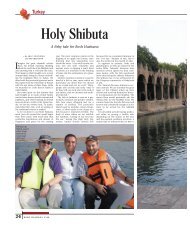
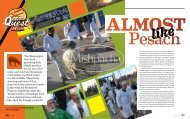


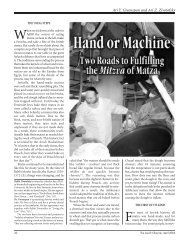
![llVtlwnl 1p1l 1biip 3 K11lnM o1it1 [1] - Halachic Adventures](https://img.yumpu.com/35271577/1/190x253/llvtlwnl-1p1l-1biip-3-k11lnm-o1it1-1-halachic-adventures.jpg?quality=85)

